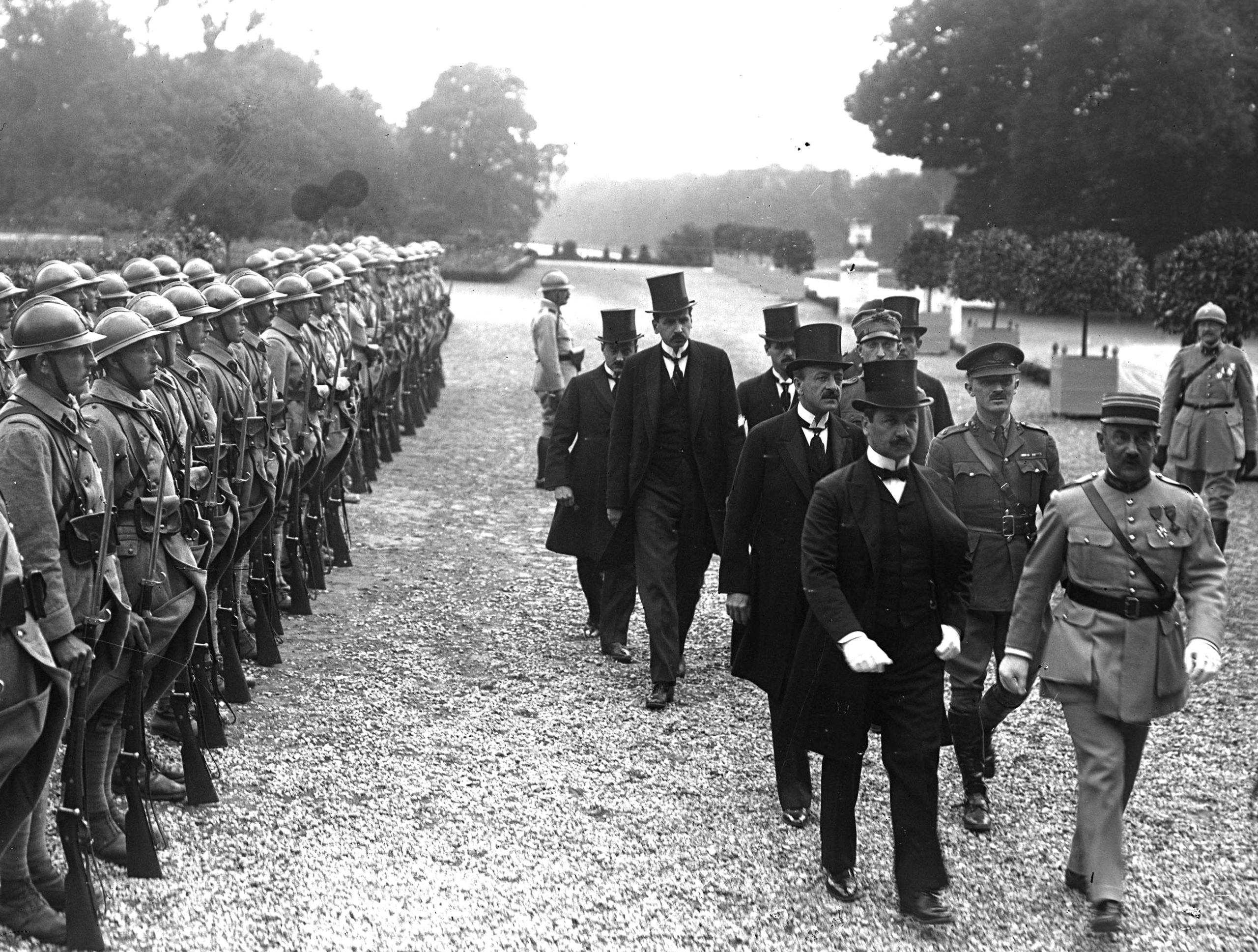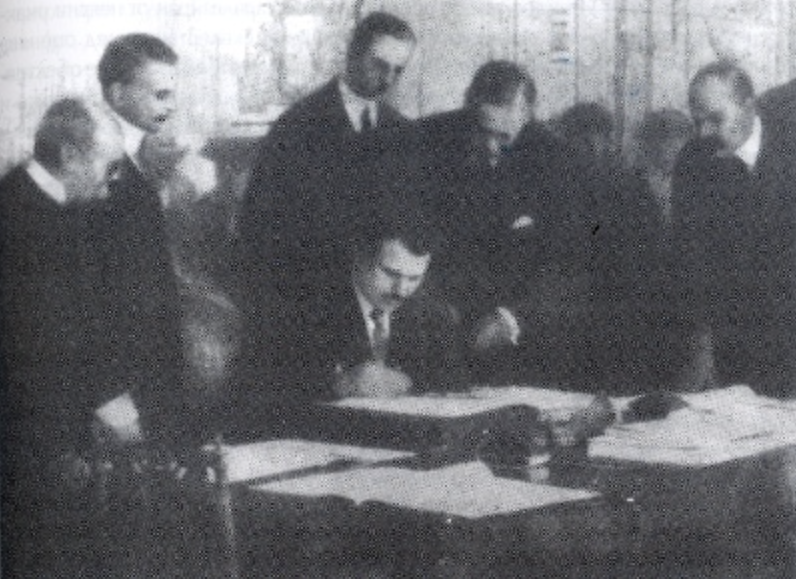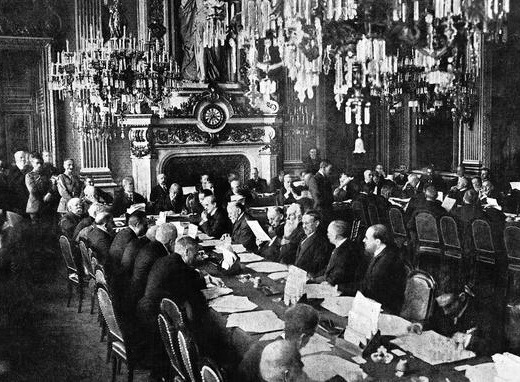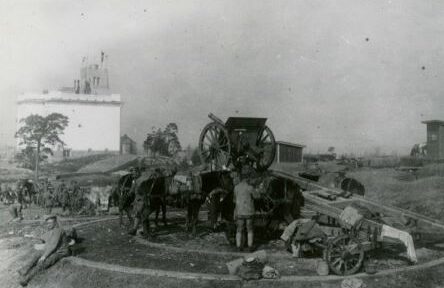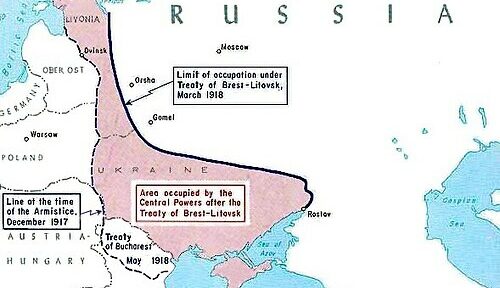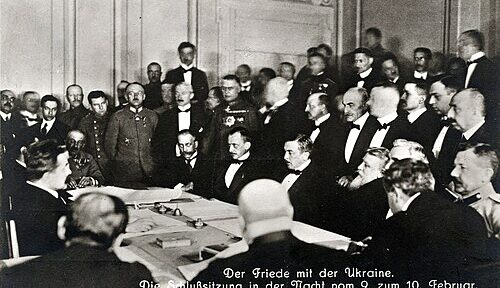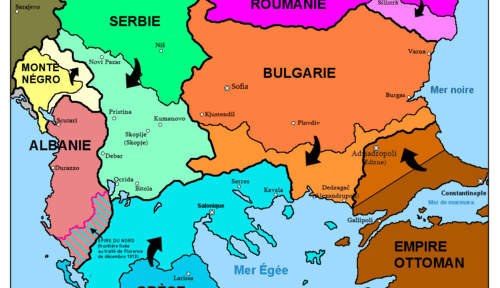Traité de paix de Bucarest
ROUMANIE, GRÈCE, MONTÉNÉGRO, SERBIE, BULGARIE.
Traité de paix; signé à Bucarest, le 28 juillet/10 août 1913, suivi de deux Procès-verbaux d’échange des ratifications.*)
Publication officielle. Bucarest 1913.
Traité de paix.
Leurs Majestés le Roi de Roumanie, le Roi des Hellènes, le Roi de Monténégro et le Roi de Serbie, d’une part, et Sa Majesté le Roi des Bulgares, d’autre part, animés du désir de mettre fin à l’état de guerre actuellement existant entre Leurs pays respectifs, voulant, dans une pensée d’ordre, établir la paix entre Leurs peuples si longtemps éprouvés, ont résolu de conclure un Traité définitif de paix. Leurs dites Majestés ont, en conséquence, nommé pour Leurs Plénipotentiaires, savoir:
Sa Majesté le Roi de Roumanie:
Son Excellence Monsieur Titus Maioresco, Son Président du Conseil des Ministres, Ministre des Affaires Étrangères;
Son Excellence Monsieur Alexandre Marghiloman, Son Ministre des Finances;
Son Excellence Monsieur Take Ionesco, Son Ministre de l’Intérieur;
Son Excellence Monsieur Constantin G. Dissesco, Son Ministre des Cultes et de l’Instruction Publique;
Le Général de division aide de camp C. Coanda, Inspecteur général de Partillerie, et
Le Colonel C. Christesco, Sous-chef du grand état-major de Son armée. Sa Majesté le Roi des Hellènes:
Son Excellence Monsieur Élefthérios Venizélos, Son Président du Conseil des Ministres, Ministre de la Guerre;
Son Excellence Monsieur Démétrios Panas, Ministre Plénipotentiaire;
Monsieur Nicolas Politis, Professeur de droit international à l’Université de Paris;
Le Capitaine Ath. Exadactyios, et
Le Capitaine C. Pali.
Sa Majesté le Roi de Monténégro:
Son Excellence le Général Serdar Ianko Voukotitch, Son Président du Conseil des Ministres, Ministre de la Guerre, et
Monsieur Jean Matanovitch, Ancien Chargé d’Affaires de Monténégro à Constantinople.
Sa Majesté le Roi de Serbie:
Son Excellence Monsieur Nicolas P. Pachitch, Son Président du Conseil des Ministres, Ministre des Affaires Etrangères;
Son Excellence Monsieur Mihailo G. Ristitch, Son Envoyé Extraordinaire et Ministre Plénipotentiaire à Bucarest;
Son Excellence Monsieur le Docteur Miroslaw Spalaikovitch, Envoyé Extraordinaire et Ministre Plénipotentiaire;
Le Colonel K. Smilianitch, et
Le Lieutenant Colonel D. Kalafatovitch.
Sa Majesté le Roi des Bulgares:
Son Excellence Monsieur Dimitri Tontcheff, Son Ministre des Finances;
Le Général-Major Ivan Fitcheff, Chef de l’état-major de Son armée;
Monsieur Sawa Ivantchoff, docteur en droit, ancien Vice-Président du Sobranié;
Monsieur Siméon Radeff, et
Le Lieutenant Colonel d’état-major Constantin Stancioff.
Lesquels, suivant la proposition du Gouvernement Royal de Roumanie, se sont réunis en Conférence à Bucarest, munis de pleins pouvoirs, qui ont été trouvés en bonne et due forme.
L’accord s’étant heureusement établi entre eux, ils sont convenus des stipulations suivantes:
Art. 1 – Il y aura, à dater du jour de l’échange des ratifications du présent Traité, paix et amitié entre Sa Majesté le Roi de Roumanie, Sa Majesté le Roi des Hellènes, Sa Majesté le Roi du Monténégro, Sa Majesté le Roi de Serbie et Sa Majesté le Roi des Bulgares, ainsi qu’entre Leurs héritiers et successeurs, Leurs États et sujets respectifs.
Art. 2 – Entre le Royaume de Bulgarie et le Royaume de Roumanie, l’ancienne frontière entre le Danube et la Mer Noire est, conformément au procès-verbal arrêté par les Délégués militaires respectifs et annexé au Protocole No. 5 du 22 juillet (4 août) 1913 de la Conférence de Bucarest, rectifiée de la manière suivante:
La nouvelle frontière partira du Danube, en amont de Turtukaia, pour aboutir à la Mer Noire au Sud d’Ekrene.
Entre ces deux points extrêmes, la ligne frontière suivra le tracé indiqué sur les cartes 1/100.000 et 1/200.000 de l’état-major roumain, et selon la description annexée au présent article.
Il est formellement entendu que la Bulgarie démantèlera, au plus tard dans un délai de deux années, les ouvrages de fortifications existants et n’en construira pas d’autres à Roustchouk, à Schoumia, dans le pays intermédiaire, et dans une zone de vingt kilomètres autour de Baltchik.
Une commission mixte, composée de représentants des deux Hautes Parties contractantes, en nombre égal des deux côtés, sera chargée, dans les quinze jours qui suivront la signature du présent Traité, d’exécuter sur le terrain le tracé de la nouvelle frontière, conformément aux stipulations précédentes. Cette commission présidera au partage des biens-fonds et capitaux qui ont pu jusqu’ici appartenir en commun à des districts, des communes, ou des communautés d’habitants séparés par la nouvelle frontière. En cas de désaccord sur le tracé et les mesures d’exécution, les deux Hautes Parties contractantes s’engagent à s’adresser à un gouvernement tiers ami pour le prier de désigner un arbitre dont la décision sur les points en litige sera considérée comme définitive.
Art. 3 – Entre le Royaume de Bulgarie et le Royaume de Serbie, la frontière suivra, conformément au procès-verbal arrêté par les Délégués militaires respectifs et annexé au Protocole Nr. 9 du 25 juillet (7 août) 1915 de la Conférence de Bucarest, le tracé suivant:
La ligne frontière partira de l’ancienne frontière, du sommet Patarica, suivra l’ancienne frontière turco-bulgare et la ligne de partage des eaux entre le Vardar et la Strouma, à l’exception de la haute vallée de la Stroumitza qui restera sur territoire serbe; elle aboutira à la montagne Bela Siéa, où elle se reliera à la frontière bulgaro-grecque. Une description détaillée de cette frontière et son tracé sur la carte 1/200 000 de l’étatmajor autrichien, sont annexés au présent article.
Une commission mixte, composée de représentants des deux Hautes Parties contractantes, en nombre égal des deux côtés, sera chargée, dans les quinze jours qui suivront la signature du présent Traité, d’exécuter sur le terrain le tracé de la nouvelle frontière, conformément aux stipulations précédentes.
Cette commission présidera au partage des biens-fonds et capitaux qui ont pu jusqu’ici appartenir en commun à des districts, des communes, ou des communautés d’habitants séparés par la nouvelle frontière. En cas de désaccord sur le tracé et les mesures d’exécution, les deux Hautes Parties contractantes s’engagent à s’adresser à un gouvernement tiers ami pour le prier de désigner un arbitre dont la décision sur les points en litige sera considérée comme définitive.
Art. 4 – Les questions relatives à l’ancienne frontière serbo-bulgare seront réglées suivant l’entente intervenue entre les deux Hautes Parties contractantes, constatée dans le Protocole annexé au présent article.
Art. 5 – Entre le Royaume de Grèce et le Royaume de Bulgarie, la frontière suivra, conformément au procès-verbal arrêté par les Délégués militaires respectifs et annexé au Protocole No. 9 du 25 juillet (7 aout) 1913 de la Conférence de Bucarest, le tracé suivant :
La ligne frontière partira de la nouvelle frontière bulgaro-serbe sur la crête de Belasica planina, pour aboutir à l’embouchure de la Mesta à la Mer Égée.
Entre ces deux points extrêmes, la ligne frontière suivra le tracé indiqué sur la carte 1/200.000 de l’état-major autrichien et selon la description annexée au présent article.
Une commission mixte, composée de représentants des deux Hautes Parties contractantes, en nombre égal des deux côtés, sera chargée, dans les quinze jours qui suivront la signature du présent Traité, d’exécuter sur le terrain le tracé de la frontière conformément aux stipulations précédentes.
Cette commission présidera au partage des biens-fonds et capitaux qui ont pu jusqu’ici appartenir en commun à des districts, des communes, ou des communautés d’habitants séparés par la nouvelle frontière. En cas de désaccord sur le tracé et les mesures d’exécution, les deux Hautes Parties contractantes s’engagent à s’adresser à un Gouvernement tiers ami pour le prier de désigner un arbitre dont la décision sur les points en litige sera considérée comme définitive.
Il est formellement entendu que la Bulgarie se désiste, dès maintenant, de toute prétention sur l’île de Crète.
Art. 6 – Les Quartiers généraux des armées respectives seront aussitôt informés de la signature du présent Traité. Le Gouvernement bulgare s’engage à ramener son armée, dès le lendemain de cette signification, sur le pied de paix. Il dirigera les troupes sur leurs garnisons et l’on procédera, dans le plus bref délai, au renvoi des diverses réserves dans leurs foyers.
Les troupes dont la garnison se trouve située dans la zone d’occupation de l’armée de l’une des Hautes Parties contractantes, seront dirigées sur un autre point de l’ancien territoire bulgare et ne pourront regagner leurs garnisons habituelles qu’après évacuation de la zone d’occupation susvisée.
Art. 7 – L’évacuation du territoire bulgare, tant ancien que nouveau, commencera aussitôt après la démobilisation de l’armée bulgare, et sera achevé au plus tars dans la quinzaine.
Durant ce délais, pour l’armée d’opération roumaine, la zone de démarcation sera indiquée par la ligne Sistov-Lovcea-Turski-Izvor-Glozene-Zlatitza-Mirkovo-Araba-Konak-Orchania-Mezdra-Vratza-Berkovitza-Lom-Danube.
Art. 8 – Durant l’occupation des territoires bulgares, les différentes armées Vous avez le droit de réquisition, moyennant paiement en espèces.
Elles y auront le libre usage des lignes de chemin de fer pour les transports de troupes et les approvisionnements de toute nature, sans qu’il y ait lieu à indemnité au profit de l’autorité locale.
Les malades et les blessés y seront sous la sauvegarde des dites armées.
Art. 9 – Aussitôt que possible après l’échange des ratifications du présent Traité, tous les prisonniers de guerre seront réciproquement rendus.
Les Gouvernements des Hautes Parties contractantes désigneront chacun des Commissaires spéciaux chargés de recevoir les prisonniers.
Tous les prisonniers aux mains d’un des Gouvernements seront livrés au commissaire du Gouvernement auquel ils appartiennent ou à son représentant dûment autorisé, à l’endroit qui sera fixé par les parties intéressées.
Les Gouvernements des Hautes Parties contractantes présenteront respectivement l’un à l’autre et aussitôt que possible après la remise de tous les prisonniers, un état des dépenses directes supportées par lui pour le soin et l’entretien des prisonniers, depuis la date de la capture ou de la reddition jusqu’à celle de la mort ou de la remise. Compensation sera faite entre les sommes dues par la Bulgarie à l’une des autres Hautes Parties contractantes et celles dues par celles-ci à la Bulgarie, et la différence sera payée au Gouvernement créancier aussitôt que possible après l’échange des états de dépenses sus-visés.
Art. 10 – Le présent Traité sera ratifié et les ratifications en seront échangées à Bucarest dans le délai de quinze jours ou plus tôt si faire se peut.
En foi de quoi, les Plénipotentiaires respectifs l’ont signé et y ont apposé leurs sceaux,
Fait à Bucarest le vingt-huitième jour du mois de juillet (dixième jour du mois d’août) de l’an mil neuf cent treize.
Signés:
Pour la Roumanie: Pour la Bulgarie:
J. Maioresco. D. Tontcheff.
Al. Marghiloman. Général Fitcheff.
Take Ionesco. Dr. S. Ivantchoff.
C. G. Dimitresco. S. Radeff.
Général aide de camp Coanda. Lt Colonel Stancioff.
Colonel C. Christesco.
Pour la Grèce:
E. K. Venizelos.
D. Panas.
N. Politis.
Capitaine A. Exadactylos.
Capitaine C. Pali.
Pour le Monténégro:
Général Serdar I. Voukotitch.
Y. Matanovitch.
Pour la Serbie:
Nik. P. Pachiteh.
M. G. Ristitch.
M. Spalaikovitch.
Colonel K. Smalianitch.
Lt Colonel D. Kalafatovitch.
Certifié conforme à l’original:
A. Pisoski.
Filitti
Protocole
annexé à l’article II du Traité de Bucarest du vingt-huit juillet (dix août) mil neuf cent treize.
Description et repérage du tracé de la nouvelle frontière bulgaro-roumaine.
Le tracé de la frontière tel qu’il est marqué sur la carte au 1/200.000 suit les lignes ou les points caractéristiques du sol tels que: vallées, vallons, sommets, ensellements, etc. Entre les villages, il suit le milieu de l’intervalle en suivant autant que possible des lignes naturelles.
I. Le tracé général.
Le tracé général part du Danube à la hauteur de l’intervalle séparant les deux îles situées au Nord-Est de l’iezer Kalimok.
(Consultez la carte au 1/200.000-ème).
Il laisse à la Bulgarie les villages :
Breslen
Kütüklü
Güvedze
Nastradin
Kascilar
Kaslaköj
Dzeferler
Kara Kodzalar
Junuzlar
Seremetköj
Jeni Balabanlar
Eski Balabanlar
Salladin
Kadir
Jükli
Ferhatlar
Saltiklar
Coban Nasuf
Sarvi
Mahmuzli
Kücük Ahmed
Bestepe
Peceli
Burhanlar
Kizildzilar
Gokce Dollük
Kapudzi Mahle
Korkut
Canlar
Emirovo
Semat
Botjovo (Jusenli)
Kara Bunar
Ermenli
Krumovo
(Kumludza grn)
Jeni Mahle
Vlahler
Klimentovo (Kapakli)
Dis Budac
Bel Monastir (Mon Aladza)
Il laisse à la Roumanie les villages :
Türk Smil
Sjanovo
Hadzifaklar
Kovandzilar
Mesim Mhale
Kara Mehmetler
Salihler
Köse Abdi
Kanipe
At Serman
Ova Serman
Omurdza
Taslimah
Rahman Asiklar
Ibrjam Mahle
Cijrekci
Kara Kadilar
Kili Kadi
Trubcular
Ehisce
Vladimirovo (Deli Osmanlar)
Serdimen
Kadijevo
Novo Botjovo
Semiz Ali
Saridza
Balidza
Kujudzuc
Mustafa-Bejler
Causkjoj
Ekrene
2. Le tracé détaillé de la frontière.
(Consultez la carte au 1/100.000-ème).
En partant du Danube, pour suivre le tracé de la frontière jusqu’à la Mer Noire, ce tracé est d’abord marqué par le pied de la terrasse de la rive gauche de la vallée séparant les villages de Tirk Smil et de Kiutiukli. Il monte ensuite l’éperon situé au Nord du chemin de Kiutiukli à Senovo, traverse le mamelon central (il y en a trois) situé à l’Ouest du village Senovo; contourne la naissance des deux vallons situés au Sud du village de Senovo, descend au débouché du vallon situé à l’Ouest du village de Hazcilar, qu’il remonte presqu’à sa naissance; traverse ensuite la vallée de Hadjifaklar ainsi que le plateau longe par la route de Kazcilar à Balbunar. Entre cette route et la cote 209 il traverse les vallées de l’Ouest et de l’Est de Kuvanojilar entre lesquelles il contourne, en suivant la crête, les vallons centraux des mêmes vallées de Kuvanojilar. A partir du Sud de la cote 209 (triangle), il se dirige vers le tournant central de la rivière de Demir-Babinar à l’est du village de Seremetkioi, qu’il touche après avoir traversé le mamelon situé au Sud-Ouest du 209 (triangle) et après avoir suivi les vallons et les confluents les plus rapprochés de la ligne droite joignant 209 (triangle) à la cote (rond) 226 (Nord de Seremetkioi). À l’est de Demir-Babinar, le tracé de la frontière suit le contrefort situé entre Kiuseabdi Kasapla et Eski Balabanlar, traverse d’abord la vallée, ensuite le plateau situé à l’est de cette vallée, entre les villages de Atkioi et Saladinkioi, il descend ensuite dans la vallée de Saormankioi au confluent du petit vallon de Saladinkioi. Le tracé traverse ensuite le mamelon situé au Nord du village de Kaidarkioi (sur la route de Silistrie) touche le confluent du vallon situé au Nord du village de Juklii pour atteindre la route de Schoumla a Silistrie, au Sud de la cote 269 (triangle), après avoir contourné à l’ouest, au Sud et à l’est le village de Rahman Asiclar, en passant par les confluents ou par les dépressions les mieux situées pour fixer ce tracé à peu près à égale distance des villages que la frontière sépare dans cette région. À partir de 269 (triangle) le tracé passe entre Dorutlar et Cioban Nasuf ; descend aux confluents des deux premiers vallons situés à l’est du village de Cioban Nasuf, suit l’éperon flanqué de ces deux vallons, court toujours vers le Sud-Est. En suivant le thalweg du vallon débouchant dans la rivière de Reonagol au Nord-Ouest de Mahmuzlai. Il descend ensuite le cours de cette rivière jusqu’au confluent situé au Nord-Ouest du vallon de Mahmuzlai, qu’il remonte ensuite pour passer au Sud du mamelon 260 (ensellement) d’où il descend dans le vallon de Kiuciuk Ahmed à l’embranchement des chemins. Après avoir remonté un peu le cours de cette rivière, le tracé de la frontière monte le contrefort situé entre Kiuciuk Ahmed et Killi-Kadai, traverse le mamelon 260, rejoint le confluent des deux vallons situés à l’ouest de Ekisce, remonte le vallon situeé 4 Ouest de ce village, change de direction vers le Sud, traverse le mamelon 277 ainsi que l’ensellement des mamelons situés entre les villages de Vladimirov et Gekcidelink ; il traverse encore l’ensellement situé entre les villages de Gekcidelink et Kapudjimah, d’où il se dirige d’abord vers le Nord et ensuite vers l’Est en suivant la dépression qui passe au Nord de Kortut (Korkut). Entre Kortut et le ruisseau Isikli, le tracé de la frontière suit la ligne de partage des eaux, au Sud du village de Kadikioi. Et de la côte 303 jusqu’au grand tournant de Isikli. Dans la section suivante, qui se termine sur la route de Varna à Dobrici, la frontière suit d’abord le cours de la vallée de Kumbudja, ensuite la branche orientale de cette vallée, en passant au Nord du mamelon 340. La dernière section — du tracé de la frontière, situé entre la route de Varna-Dobrici et la Mer Noire, traverse à son origine le vallon de Kuiudjuk, suit un petit contrefort, ensuite un vallon dans la direction Sud-Est, il s’engage ensuite vers le Nord-Est dans la direction de la côte 299 en suivant une ligne de partage des eaux ; il sépare ensuite par les lignes caractéristiques du terrain les villages de Ciauskioi, de Kapaklii, après avoir, de la même manière, séparé Mustafa Beiler de Vlahlar ; il touche enfin la Mer Noire en traversant Pensellement situé au Sud de la côte 252.
3. Le Repérage Provisoire du Tracé.
Le tracé de la frontière ainsi défini topographiquement a été fait à l’aide des documents cartographiques existants (les cartes de 1/200.000, 1/126.000 et 1/100.000) se trouve encore rapporté à certains points remarquables du sol. À cet effet, on a d’abord choisi les points trigonométriques de la triangulation existante, puis les clochers des églises ou les minarets des villages. C’est pourquoi on a inclus ce tracé dans une triangulation développée entre le Danube et la Mer Noire. La triangulation coupant le tracé de la frontière, les intersections se trouvent repérées par des points invariables du sol, dont on peut mesurer la distance avec une approximation de 50 m.
C’est ainsi que le point de départ de la frontière du Danube est rapporté à la cote du point trigonométrique de Turtucaia qui se trouve à une distance de 15 km. De la même manière, on peut lire sur la carte les distances de tous les mamelons, ensellements, etc., qui forment les jalons de la frontière.
Fait à Bucarest, le 28 juillet (10 août) 1913.
Signés:
Pour la Roumanie :
T. Maïoresco.
Al. Marghiloman.
Take Ionesco.
C. G. Dissesco.
Général aide de camp Coanda.
Colonel C. Christesco.
Pour la Bulgarie:
D. Tontcheff.
Général Fitcheff.
Dr S. Ivantchoff.
S. Radeff.
Lt Colonel Stancioff
Pour la Grèce:
E. K. Veniselos.
D. Panas.
N. Politis.
Capitaine A. Exadactylos.
Capitaine Pali.
Pour le Monténégro:
Général Serdar I. Voukotitch.
I. Matanovitch.
Pour la Serbie:
Nik. P. Pachitch.
M. G. Ristitch.
M. Spalaikovitch.
Colonel K. Smilianitch.
Lt Colonel D. Kalafatovitch
Protocole
Annexe à l’article III du Traité de Bucarest du vingt-huit juillet (dix août) mille neuf cent treize.
Description détaillée de la nouvelle frontière bulgaro-serbe.
La ligne de frontière part au Nord de l’ancienne frontière bulgaro-serbe, du point Patarica, suit l’ancienne frontière bulgaro-turque jusqu’à Dizderica, suit ensuite la ligne de partage des eaux entre le Vardar et la Strouma en passant par Lukov vrh (1297), Obel, Poljana, la cote 1458, la cote 1495, Zanoga (1415), Ponorica, Kadica, la cote 1900, la cote 1453, Cingane Kalessi, la crête de Klepalo, la cote 1530, la crête de Males planina (1445), tourne à l’ouest vers les cotes 1514 et 1300, passe par la crête de Draganeva dag, Kadi mesar tepesi, Kale tepesi, traverse la rivière Noviéanska au sud du village de Rajanci, passe entre les villages Oslovei et Sugevo, traverse la rivière Stroumica entre Radiéevo et Vladovci et remonte vers la cote 850, suit de nouveau la ligne de partage des eaux entre le Vardar et la Strouma par les cotes 957, 571, 750, 895, 850 et atteint la crête de la montagne BelaSica où elle se relie à la frontière bulgaro-grecque.
Fait à Bucarest, le 28 juillet (10 août) 1913.
Signés :
Pour la Roumanie :
T. Maïoresco.
Al. Marghiloman.
Take Ionesco.
C. G. Dissesco.
Général aide de camp Coanda.
Colonel C. Christesco.
Pour la Bulgarie:
D. Tontcheff.
Général Fitcheff.
Dr S. Ivantchoff.
S. Radeff.
Lt Colonel Stancioff
Pour la Grèce:
E. K. Veniselos.
D. Panas.
N. Politis.
Capitaine A. Exadactylos.
Capitaine Pali.
Pour le Monténégro:
Général Serdar I. Voukotitch.
I. Matanovitch.
Pour la Serbie:
Nik. P. Pachitch.
M. G. Ristitch.
M. Spalaikovitch.
Colonel K. Smilianitch.
Lt Colonel D. Kalafatovitch
Protocole
annexé à l’article IV du Traité de Bucarest du vingt-huit juillet (dix août) mil neuf cent treize, concernant les questions relatives à l’ancienne frontière serbo-bulgare.
Une commission mixte serbo-bulgare, qui sera constituée dans le délai d’un an à partir du jour de la ratification du Traité de paix, réglera les questions relatives à l’ancienne frontière serbo-bulgare, en prenant pour principe le talweg du Timok, en tant que cette rivière sert de frontière entre la Serbie et la Bulgarie, et la ligne de partage des eaux pour la partie de la frontière depuis le sommet de la hauteur de Batchichte jusqu’à Ivanova Livada.
Au plus tard dans un délai de trois ans à partir du jour de la ratification du Traité de paix, les deux Hautes Parties contractantes sont tenues de marquer sur le terrain par des signes permanents tout le tracé de l’ancienne frontière serbo-bulgare.
Tous les moulins existant sur le Timok, en tant que celui-ci sert de frontière entre la Serbie et la Bulgarie, seront supprimés dans le délai de trois ans à partir du jour de la ratification du Traité de paix, et dorénavant aucune installation de ce genre ne sera permise sur cette partie de la rivière.
Il est également entendu qu’il ne sera plus permis désormais aux sujets respectifs des deux Hautes Parties contractantes de posséder des biens-fonds divisés par la ligne-frontière (les biens dits ,dvovlassna ‘). En ce qui concerne les propriétés de cette nature actuellement existantes, chacun des deux Gouvernements s’engage à procéder à l’expropriation, moyennant une juste et préalable indemnité fixée d’après la procédure locale, des parcelles sises en deçà de sa frontière. La même règle s’applique aux biens situés dans l’enclave de Rogliévo-Koilovo ainsi que dans celle de Halovo-Vrageogrntzi, leur situation juridique par rapport aux administrés des deux Etats riverains ayant été réglée par le Protocole No. 11 de la Commission mixte serbo-bulgare de 1912. Lesdites expropriations seront effectuées dans le délai de trois ans au plus tard, à partir du jour de la ratification du Traité de paix.
Fait à Bucarest, le 28 juillet (10 août) 1913.
Signés :
Pour la Roumanie :
T. Maïoresco.
Al. Marghiloman.
Take Ionesco.
C. G. Dissesco.
Général aide de camp Coanda.
Colonel C. Christesco.
Pour la Bulgarie:
D. Tontcheff.
Général Fitcheff.
Dr S. Ivantchoff.
S. Radeff.
Lt Colonel Stancioff
Pour la Grèce:
E. K. Veniselos.
D. Panas.
N. Politis.
Capitaine A. Exadactylos.
Capitaine Pali.
Pour le Monténégro:
Général Serdar I. Voukotitch.
I. Matanovitch.
Pour la Serbie:
Nik. P. Pachitch.
M. G. Ristitch.
M. Spalaikovitch.
Colonel K. Smilianitch.
Lt Colonel D. Kalafatovitch
Protocole
annexé à l’article V du Traité de Bucarest du vingt-huit juillet (dix août) mil neuf cent treize.
Frontière définitive entre la Bulgarie et la Grèce.
(Carte autrichienne 1/200.000.)
La ligne frontière commence sur la crête de la Belasica planina, à partir de la frontière bulgaro-serbe ; suit cette crête, puis descend la crête qui se trouve au Nord de Jirtkleri et va jusqu’au confluent de la Strouma et de la Bistrica, remonte la Bistrica, puis se dirige vers l’Est à Cengané Kalesi (1500). De là, elle atteint la crête d’Ali Butus (côte 1650) et suit la ligne de partage des eaux, côtes 1820, 1800, 713 et Stragaé. En suivant toujours la ligne de partage des eaux, elle se dirige vers le Nord, puis vers le Nord-Est, pour suivre la ligne de partage des eaux entre les côtes 7195, 660 et atteindre les côtes 1150 et 1152. De là, en suivant la crête à l’Est du village Rakisten, elle traverse la Mesta, se dirige vers le sommet de Rusa et Zeleza, traverse la Despat (Rana) suju et atteint Cuka. À partir de ce point, elle reprend la ligne de partage des eaux et, en passant par Sibkova, Cadirkaya (1750), Avlika dag (1517), Kajin Cal (1811), Debikli (1587), descend vers le Sud à la côte 985, pour tourner vers l’Est au Sud du village Karovo, de là se dirige vers l’Est, passe au Nord du village Kajbova, remonte vers le Nord et passe par les côtes 1450, 1538, 1350 et 1845. De là, elle descend vers le Sud en passant par Cigla (1750), Ku?lar (2177). À partir de Ku?lar, la ligne frontière suit la ligne de partage des eaux de la Mesta et du lassi Evren dère par Rujan pl. et atteint Achlat dagi (1300), suit la crête qui se dirige vers la station du chemin de fer à Okéilar (41) et à partir de ce point suit le cours de la Mesta pour aboutir à la Mer Egée.
Fait à Bucarest, le 28 juillet (10 août) 1913.
Signés :
Pour la Roumanie :
T. Maïoresco.
Al. Marghiloman.
Take Ionesco.
C. G. Dissesco.
Général aide de camp Coanda.
Colonel C. Christesco.
Pour la Bulgarie:
D. Tontcheff.
Général Fitcheff.
Dr S. Ivantchoff.
S. Radeff.
Lt Colonel Stancioff
Pour la Grèce:
E. K. Veniselos.
D. Panas.
N. Politis.
Capitaine A. Exadactylos.
Capitaine Pali.
Pour le Monténégro:
Général Serdar I. Voukotitch.
I. Matanovitch.
Pour la Serbie:
Nik. P. Pachitch.
M. G. Ristitch.
M. Spalaikovitch.
Colonel K. Smilianitch.
Lt Colonel D. Kalafatovitch
Certifié conforme à l’original:
A. Pisoski
Filitti
